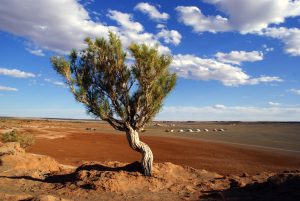The 2022 United Nations Climate Change Conference in Glasgow was an eye-opener for Mongolia. After attending the conference, the president of Mongolia, Khurelsukh Ukhnaa, launched a nationwide movement to plant 1 billion trees by 2030 as part of Mongolia’s commitment to the United Nations Sustainable Development Goals, as well as a way to fight desertification, deforestation, and food insecurity.
Since November 2021, the Office of the President and the Ministry of Environment and Tourism have been actively promoting the One Billion Tree nationwide movement. In March, the president officially announced the beginning phase of the project. As of June, 21 provinces (aimags) and 330 sub-provinces (sum) are participating in the seedling process.
In a five-minute promo video, governors from different provinces have pledged to plant 20,000 seedling in their respective provinces. Provinces such as Selenge, Darkhan, Bayankhongor, Tov, and Dornigovi have already started the seedling process.
The president’s economic and environmental policy advisory team, in cooperation with the Ministry of Environment and Tourism, is encouraging mining conglomerates and other entities in the public and private sectors to participate via government contracts. Since November 2021, 21 large corporations such as Erdenes Tavan Tolgoi, Oyu Tolgoi, Tavan Tolgoi, Energy Resource, and Erdenet Mining Corporation have signed government contracts and pledged to plant 608.5 million trees.
In a nationwide combined effort, the president is hoping to seed around 640,000 seedlings at a cost of 4.3 billion tugriks. According to the Mongolian Mining Journal, Mongolia will spend 1 percent of the national GDP on the One Billion Tree mega project.
When discussing Mongolia’s environmental issues, it is important to note that the northern parts of the country and its ecosystems are very different from the south, where the Gobi Desert occupies a large territory. Dornigovi’s provincial administration stated that, due to the Gobi Desert’s unique environment and ecosystem, the trees and plants that will be seeded in this area will be different from other areas and will require extra care. These regions are already combating desertification.
Mongolia’s extreme climate and its diverse ecosystems pose a challenge for policymakers looking to implement realistic, sustainable action-based goals. Throughout different administrations, Mongolian policymakers have initiated and implemented a variety of environmental policies. But these efforts are often disrupted by elections, resulting in changes of national and provincial administrations. Hence, these green projects rarely even received the necessary funding, let alone bringing successful results. It is fair to say that climate change has not really been a top priority for the Mongolian government.
According to the Montsame News Agency, Mongolia’s One Billion Tree nationwide movement will be implemented in three phases. The first phase will be completed by 2024, and intensification process will take two years, from 2024-2026. By 2027, the participatory parties should already be in the sustainable stage.
Khurelsukh hopes that the One Billion Tree nationwide movement will continue even after his single six-year term as president, which ends in 2027. During his speech at the U.N. General Assembly, he reiterated Mongolia’s fight against climate change, particularly emerging issues such as deforestation and desertification. These issues in many ways illustrate the larger struggle in highly urbanized modern Mongolia, where native sites are being taking over by mining-heavy industries.
On the other hand, the Mongols, known for their nomadic lifestyle, traditionally did not dwell in one place for a prolonged period. Hence, agriculture and prolonged environmental care has never been a breadwinner for Mongolian society.
As the global fight against climate change has become a main theme for environmentalists and conservationists, it is in Mongolia’s interest to be informed, involved, and active. Given Mongolia’s vast landscape, it is imperative for policymakers to implement policies that both treat current problems and help prevent further damage. Can Mongolia’s One Billion Tree nationwide movement be such a dual-purposed policy?
From a policy perspective, the implementation of this mega project will require continued federal and local funds. Equally important, the continuity mechanisms must prove that Khurelsukh’s initiation is not just for a showcase for Mongolia, but an action-based fight against many emerging issues. The biggest hope is that the participating parties will pick up the torch and continue the movement beyond any political change.

































